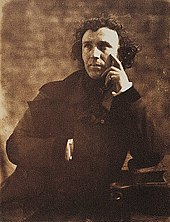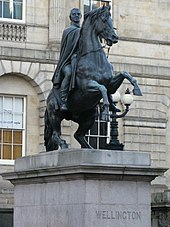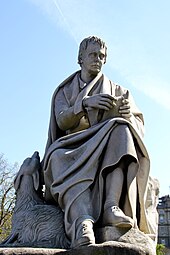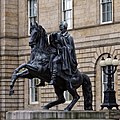Biography
Steell was born in Aberdeen, but his family moved to 5 Calton Hill in Edinburgh in 1806. [3] He was one of the thirteen children (eleven surviving beyond infancy) of John Steell senior (1779–1849), a carver and gilder, and his wife, Margaret Gourlay, the daughter of William Gourlay, a Dundee shipbuilder. As the family grew they moved to a larger house at 20 Calton Hill. [4] Due to his father's own fame as a sculptor, for much of his early working career he is referred to as John Steel Junior.
Steell initially followed his father, training to be a carver himself, being apprenticed in 1818. In 1819 his father was declared bankrupt by the Trades of Calton, bringing much shame on the family. [5] However, John Junior showed artistic talent, and despite this, the family sent him to study art at the Trustees Academy in Edinburgh, under Andrew Wilson. [6]
Working with his father from studios at 6 Hanover Street, his first major step came in 1827 when the North British Fire Insurance Company, at 1 Hanover Street, commissioned a huge timber statue of St Andrew to be placed on the outside of their office. now housed within the Lodge Room premises of Lodge Dalkeith Kilwinning in Dalkeith. The work appears closely based on a sketch of a statue of St Andrew in Rome by François Duquesnoy. As the office stood immediately opposite the Royal Scottish Academy it was quickly noticed by Edinburgh's artistic society, and acknowledged as a fine work. In 1829, spurred on by the success of this work, he travelled to Rome to study sculpture more intensely. [7]
The first work to attract international attention was Alexander taming Bucephalus carved in 1832–33 (cast in bronze in 1883, and now standing in the quadrangle of Edinburgh City Chambers). [8] Around 1838 he was appointed as Sculptor to Her Majesty the Queen, a post which was later recognised as part of the Royal Household in Scotland. [9] In 1840 he opened Scotland's first foundry on Grove Street in Edinburgh, dedicated to sculpture, to cast his statue of Wellington himself. [10]
In 1854 he commissioned a new house for himself at 24 Greenhill Gardens and lived there for the rest of his life. His fame by then was international, receiving commissions from the United States, Canada and New Zealand. Prior to this he had lived at 3 Randolph Place on the edge of the Moray Estate in Edinburgh's West End. [11]
He exhibited at the Royal Scottish Academy and the Royal Academy, and was knighted in 1876 following the unveiling, by Queen Victoria, of his statue The Prince Consort, which stands in the centre of Charlotte Square in Edinburgh. [12]
Steell died at home, 24 Greenhill Gardens [13] in Edinburgh's southern suburbs, on 15 September 1891 and is buried in an unmarked grave in Edinburgh's Old Calton Cemetery. This grave was purchased by his father John Steell senior and many members of the Steell and Gourlay families are also interred there.
Family
In 1826 he married Elizabeth Graham, daughter of John Graham, an Edinburgh merchant.
His eldest son, William Steell (1836–1917), appears to have been an architect but of minimal note. One of his few recorded works is the pedestal for John's statue of Dr Thomas Chalmers on George Street in Edinburgh. [14]
His youngest son, Graham Steell [15] was a prominent British physician and cardiologist who is best known for identifying the cardiac murmur that bears his name.
Sir John Steell's brother Gourlay Steell was a noted animal painter: he was Queen Victoria's animal painter, taking over from Sir Edwin Landseer. Many of Gourlay Steell's paintings remain in the private collection of Queen Elizabeth II. His portrait was painted by Robert Scott Lauder and William Grant Stevenson (Aberdeen Art Gallery).
This page is based on this
Wikipedia article Text is available under the
CC BY-SA 4.0 license; additional terms may apply.
Images, videos and audio are available under their respective licenses.












